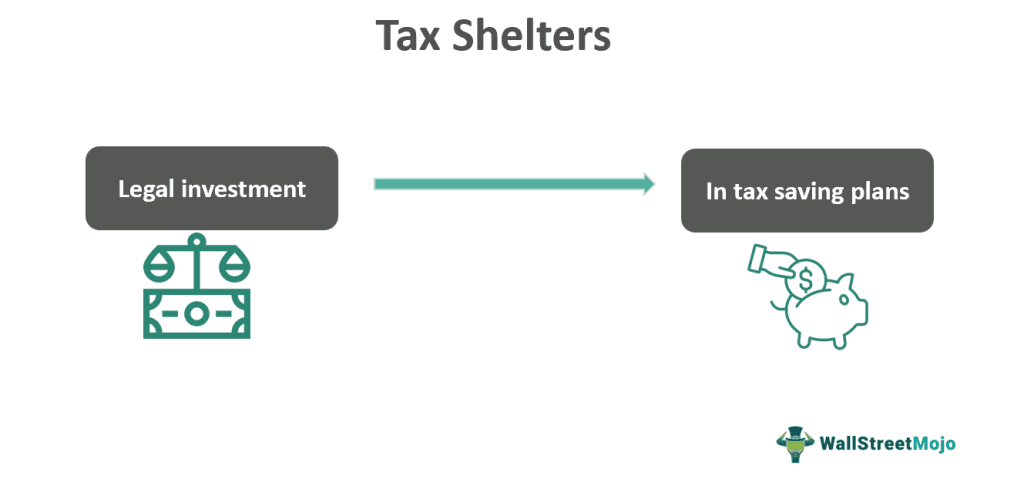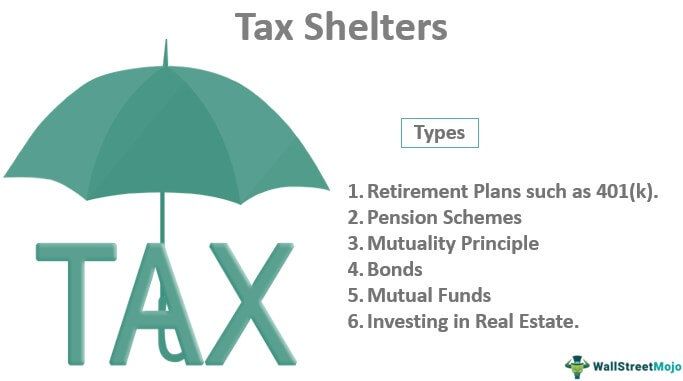Table Of Contents
What Are Tax Shelters?
A tax shelter is a legal way of investing in certain plans or schemes that reduce the overall taxable income of the taxpayers and therefore save the taxes paid to the state or federal governments. For example, several retirement plans are available for any individual to opt for that help reduce tax liabilities.

Tax laws and Government policies provide us with many platforms to save taxes in legal ways. Some retirement policies like 401(k) help us save money as well as the tax on our earned income. Thus by keeping aside some small amount from our earnings, we can save and build a corpus for the future. Some critics say that tax shelters are negative.
How Do Tax Shelters Work?
Tax shelters are methods through which the tax payable are either reduced or deferred for a future date. It is used by both individuals and entities to decrease their tax liabilities. They are legal methods that commonly include any type of investment that will have tax benefits or good tax treatments, deductions and credits.
Retirement plans as well as municipal bonds are very good examples of the same. Such a tax reduction strategy is very different from tax evasion or avoidance. They are very transparent and legal, providing great opportunities for taxpayers to invest their money to ear return and at the same time pay less tax. This investment fund is in turn used by government of corporates for development and other useful purposes.
There are many insurance and real estate investment products also that act as good tax shelters. The reduction in tax bills is beneficial for taxpayers even though the long-term return on such investments may be taxable when withdrawn.
Overall, this concept is very desirable from the perspective of both individual and the society as a whole. Some tax shelter options may also have some social benefits in the form of contribution to infrastructural development.
Types
The concept of good tax shelters should be well understood by all those who want to retain and grow their hard-earned money and to get tax benefits or deduction in tax or maybe a considerable relaxation on withdrawal.
- Retirement plans, such as 401(k);
- Pension schemes
- Mutuality principle
- Bonds
- Mutual funds
- Investing in real estate;

Strategies
Here are some valuable strategies of real estate tax shelters and others too, that are typically followed during the process.
- Very often the tax liability is minimised. The taxpayers may try to do it either by reducing the amount of income that may be taxable of set off some part of the profits against the taxable loses. This will reduce the income on which tax may be charged.
- Apart from that they may make investments in opportunities that offer substantial tax deductions, This too reduce the value of tax that they may have to pay. This helps them to save funds and at the same time make profitable investments that will give good returns. However, usually the money withdrawn from such investments in the form of returns or profits are also taxable.
- Sometimes tax payment is deferred. In case of retirement accounts like the traditional IRA, when the money is withdrawn, the profits are taxable. But taxes are paid in the future. Taxpayers do not have to worry about immediate tax payments.
From the above, we notice the fact that this concept of real estate tax shelters and others too, may reduce the payments either on a temporary basis or a permanent basis.
Examples
Let us understand the concept of tax shelters for high income earners with the help of some suitable examples, as given below:
- Suppose you earn $500/day and decide to set aside 10% of your income in the 410(k) plan. Now, $50 will be kept aside daily as an investment in any tax shelters. The benefit of this plan is that you must pay tax on $450/day ($500-$50) and not on the entire sum of $500. The sum which will get deposited under plan 401(k) (for example) will not be chargeable to tax. Thus, you are not required to pay any tax on that amount, which is kept aside until we withdraw.
- You work for a company that offers you certain benefits such as medical allowances, house rent allowances, and insurance for you and your family. These are also types of tax shelters since no tax will be levied over the amount involved in these benefits.
- Owning a flat or a house can also be a tax shelter because you are relieved of paying tax on the year you purchase a property.
- If you own a house worth $30,000 and additional floor worth $1,000 and you decide to sell the house after 5 years the buyer agrees to pay $75,000. After 5 years the index cost of acquisition of that house comes to $50,000. You are then required to pay tax on ($75,000 – $50,000) i.e. $25,000 and not on {$75,000 – ($30,000 + $1,000)} i.e. $44,000.
So these are some practical life-based tax shelter examples.
Going for home equity is always a great deal since the capital gain tax exemption is $250,000 from the particular sale consideration.
- The government has allowed some standard deductions for the taxpayers that are also a kind of tax shelter. The standard deduction for the individual comes to$12,000, and for married couples, those filing returns together get a standard deduction of $24,000. So if a family of husband and wife earns $70,000 and $30,000 respectively they are liable to pay tax only on {$100,000 – (2x$12,000)} or $76,000 rather than on the entire family income i.e. ($70,000 + $30,000) or $100,000.
Advantages
Some advantages of the concept of tax shelters for high income earners are given in details below:
- Easy to plan for a tax shelter investment
- A good amount of the sum can be contributed.
- Helps to reduce taxable income
- Easy withdrawal from such plans is possible.
- Provides a platform for investment by which an individual can earn returns;
- Taxes are either lowered or deferred.
- Tax benefits can easily be derived.
- On selling a house property, one can get an exemption of $250,000 on their sale consideration.
Disadvantages
Here are some noteworthy disadvantages of the concept of investment tax shelters.
- The plans are generally not very flexible.
- There are chances of penalties in case of early disbursement of the money kept aside.
- Additional taxes can also be levied in some cases.
- Some tax shelter methods or schemes are very risky.
- Returns are assured, but in some cases, the tax rate levied on that sum can be higher than the expected returns, making it a very unpredictable investment.
- Inflation also plays a very vital role. Due to adverse changes in the country's economic condition, the entire planning can be ruined.
- It is not independent.
- One of the tax shelters is to invest in real estate, but in reality, each real estate is a separate entity on its own. The ready to use real estate property has two phases under construction, and the other one is the developed phase. Both the phases are separate, and the tax treatment will be different when it is sold or lease.
- Some tax shelters are not exempted from tax, especially the cash-based transactions in which withdrawal happens.
- Risk is not hedged here.
Tax Shelter Vs Tax Avoidance
Both the above concepts are related to tax payments. But there are some differences between them, as given below:
- The investment tax shelters is related to the process followed to make investment in opportunities that will help to save tax charged on income. But the latter is the process of using opportunities to not pay tax at all, even though it should be paid.
- The former is a legal process and does not involve any issues later on with the taxation department. But the latter is not legal and may result in problems and penalties later on.
- The former results in optimum usage of investment opportunities which help in mobilization of savings and funds in the economy, whereas the latter results in funds staying blocked and lying idle, which could have been used for better purposes.
- Citizens are always encouraged to go for the former and discouraged to use the latter because the former helps government earn funds that is used for development of infrastructure and facilities for public utility. But the latter takes away such funds and leads to their misutilization.
Thus, the above are some important differences between the two taxation related concepts.
